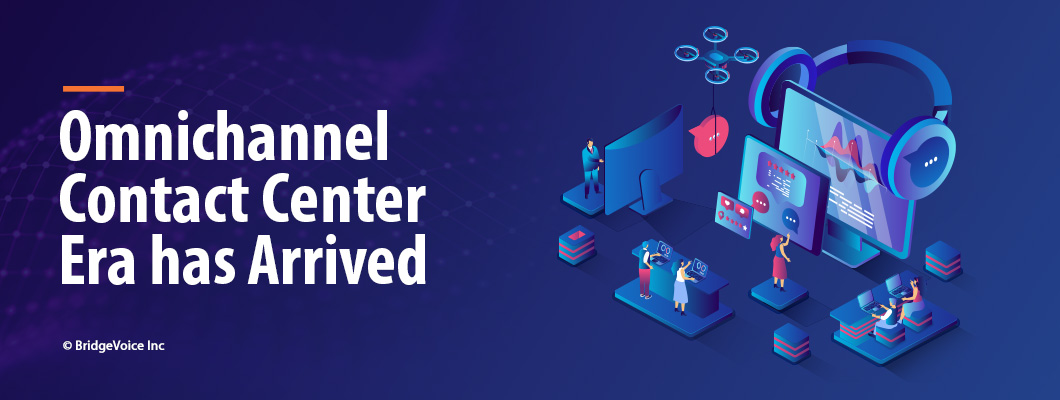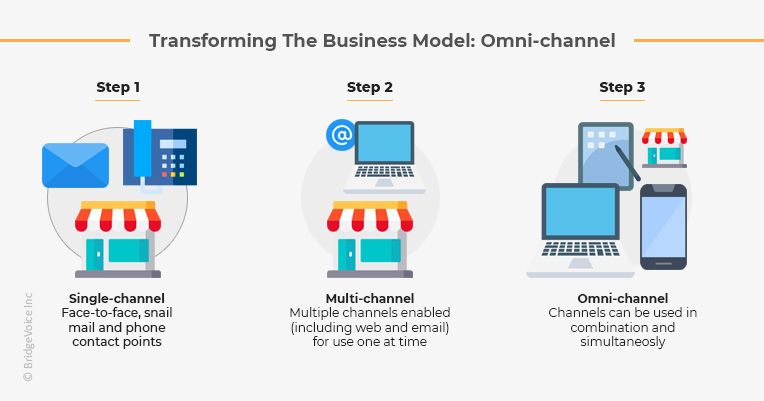The Ultimate Transformation: Shifting from a Traditional Call Center to an Omnichannel Contact Center

The days of the traditional "call center" are gone. Customer assistance, sales, and the corporate environment are no longer limited to a space with ringing phones. To upgrade the customer experience, outperform the competition, and succeed in the digital age, businesses need something more concrete. The "omnichannel contact center" age has arrived. The contact center, as we currently understand it, is an omnichannel setup created for managing communication across a variety of channels, including voice services, SMS, chat, email, video, and social media interactions.
Today's call centers are developing in a different way. They are now seen as a tactical communication tool where deeper connections with customers are potentially made to enhance the overall customer experience. This movement has been significantly influenced by the development of data science, data analysis, and data collection. With more data available, organizations may now discover untapped insights that can be used, creating customized solutions for both customers and businesses. Additionally, the availability of usable data has sparked a surge in artificial intelligence products, which has quickly transformed automation technology from awkward and challenging to something incredibly effective.
Incorporating customers' preferences into communication technology is one method to ensure they have a seamless experience, which is essential to ensuring revenue from satisfied customers. People have preferred methods of communication. Some of us like live messaging, many prefer email, and still others prefer talking on the phone. If businesses want to draw in customers, generate new sales, or increase retention of customers, they should make sure that preferences are accounted for. By enabling more dynamic communication channels with the integration of VoIP termination services and artificial intelligence (AI) and streamlining the process for consumers by removing the need for them to handle several communications streams across various media, omnichannel contact centers take the customer experience to the next level.
In the current rapidly evolving business landscape, customer expectations are changing, and businesses need to adapt to meet these expectations. The transition from conventional call centers to autonomous omnichannel contact centers has been one of the most important transformations in recent years. Let's explore what an autonomous omnichannel contact center is, the benefits of making the shift, and how businesses can make the transition.
What is an Autonomous Omnichannel Contact Center?
An autonomous omnichannel contact center is a hub for customer support that interacts with customers across a variety of channels, including voice service, chatbots, social media, email, and other digital platforms. In contrast to a traditional call center, an autonomous omnichannel contact center does not rely only on phone calls to deliver customer care. Instead, it makes use of a number of channels to make sure that clients may contact the business in the method that works best for them.
An omnichannel contact center is also autonomous, meaning that it uses artificial intelligence and automation to handle customer inquiries and help. Businesses can use AI and automation to provide customers with more personalized and efficient services.
Omnichannel contact centers' primary goals have changed over time. Previously, the omnichannel approach's solutions were mostly focused on bringing together phone and video interaction, but they are now also increasingly incorporating social media, live chat, and messaging services. Customers frequently express a clear preference for messaging-based contact over phone calls or emails, particularly younger customers. There are various factors behind this, but the primary one is the simplicity of usage. How much a communication channel will interfere with a person's regular life is one component of usability that isn't frequently discussed. As clients can utilize messaging channels concurrently with other activities, there is relatively little interruption.

Benefits of Shifting from a Single Channel Call Center to an Autonomous Omnichannel Contact Center
Businesses can gain a lot of advantages by switching from a conventional single-channel call center to an independent omnichannel contact center. Some of the main benefits include:
Improved Customer Experience
By using multiple communication channels such as voice service, SMS, email, and chatbots to interact with customers and provide faster and more efficient service through automation, businesses can improve the overall customer experience.
Increased Efficiency
Customers can contact customer support representatives on their preferred channel, with reduced wait time and quick responses to their questions, thanks to the omnichannel approach. Thus, an autonomous omnichannel contact center can handle a higher volume of inquiries and requests than a traditional call center without requiring additional staff.
Cost Savings
The benefit of using an omnichannel strategy is the ability to segment customers into the appropriate audience types and boost conversion rates. By using automation and AI to handle customer inquiries and call distribution, businesses can save money on staffing costs and improve customer service operations' return on investment (ROI).
Better Data Management
Because all the data is in a single database, organizations using an omnichannel strategy may examine their customer service data in great detail. Businesses can use consumer behavior patterns to better understand their customer’s needs and provide better services. An omnichannel contact center may gather and store information from several channels, giving businesses useful insights that might aid in decision-making.
Competitive Advantage
By offering a more personalized and efficient service than their competitors, businesses can gain a competitive advantage and attract and retain more customers.
How to Make the Transition from Single Channel Call Center to Autonomous Omnichannel Contact Center?
Transitioning from a traditional call center to an autonomous omnichannel contact center requires careful planning and implementation. The following actions can be taken by businesses to make the transition:
Evaluate Current Processes
Before making any changes, call center businesses should evaluate their current customer service processes and identify critical areas for improvement. Examine the complete current customer journey and list every point at which customers can contact the company, such as social media, email, chatbots, phone, etc.
Define Goals
Businesses should define their goals for the transition, including the channels they want to use, the level of automation they want to implement, and the metrics they will use to measure success. By figuring out the necessary channels and the customer journey for each channel, a business can map out its omnichannel strategy and determine the equipment, personnel, and training that the organization will require.
Choose the Right Technology
Select an omnichannel platform that combines all the channels and allows agents to access customer information everywhere. To achieve flawless customer interaction, businesses should choose the right technology to support their omnichannel contact center, including a customer relationship management (CRM) system, VoIP Routes Providers, communication platforms, and automation tools.
Training of Staff
Staff should be trained on the new processes and technology to ensure they can provide excellent service and use the latest customer communication channels effectively.
Monitor and Adjust
Once the new omnichannel contact center is implemented, businesses should monitor its performance and adjust as necessary to improve efficiency and the customer experience.
Transforming the Future of Omni-channel Contact Centers with VoIP Termination Service
Switching from a traditional single-channel call center to an autonomous omnichannel contact center can bring numerous benefits to businesses, including improved customer experience, increased efficiency, cost savings, and competitive advantage. Businesses can develop a customer service hub that fits the evolving needs of their consumers and offers a more individualized and effective service by carefully planning and implementing the shift.
At BridgeVoice Pluto, we provide contact centers with an incredible chance to communicate with their customers using our next-gen global voice service, DID services, and VoIP termination services. Get in touch with our team of experts to explore our VoIP solutions to accelerate the transformation of your single-channel call center to an autonomous omnichannel contact center. Contact us for a free demo.

 Fostering Authentic Connections: The Power of P2P SMS-Enabled Numbers and DID Services in Customer Engagement
Fostering Authentic Connections: The Power of P2P SMS-Enabled Numbers and DID Services in Customer Engagement